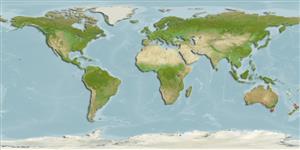>
Gobiiformes (Gobies) >
Gobiidae (Gobies) > Gobiinae
Etymology: Arenigobius: Latin, arena, harena, -ae = sand + Greek, kobios or Latin gobius = gudgeon (Ref. 45335).
More on author: Kner.
Environment: milieu / climate zone / depth range / distribution range
Ekologi
marina; brackvatten bottenlevande; djupintervall 0 - 1 m (Ref. 45534). Subtropical
Indo-West Pacific: endemic to southern Australia.
Size / Vikt / Age
Maturity: Lm ? range ? - ? cm
Max length : 7.6 cm SL hane/ej könsbestämd; (Ref. 45534); 9.1 cm SL (female)
Short description
Bestämningsnycklar | Morfologi | Morfometri
Taggstrålar i ryggfenan (totalt) : 7; Mjukstrålar i ryggfenan (totalt) : 10 - 11; Taggstrålar i analfenan: 1; Mjukstrålar i analfenan: 10. Distinguished by the following characters: body colour light brown; two oblique dark bands originating on head below eye, the upper degenerating into diffuse purplish brown blotches from the pectoral to caudal peduncle; black stripe arising at the pectoral insertion and running along lower body before breaking into small black spots above anal fin; dorsal fins with a horizontal dark band near the base; dark blue mark on membrane distally between first and second rays of D2; iridescent irregular blue blotches along flanks; three or more approximately vertical bands on upper caudal; vertebrae 10+15 (vertebral counts taken from radiograph); body cylindrical; snout blunt; eyes large, and close together dorsally; origin of pectorals under posterior margin of operculum; caudal oval and elongate; 7th pectoral ray extended into a filament; pelvics united into cup-shaped disc with branched rays; origin of pelvics covered by a loose sheath of skin; scales cycloid on belly and dorsally to second dorsal origin; posterior lateral scales peripheral ctenoid; head and predorsal region naked (Ref. 45534).
Facultative air-breathing (Ref. 126274); Found in muddy coastal areas to upper estuaries, rocky reefs, in sea grass beds and mangroves (Ref. 9002).
Life cycle and mating behavior
Könsmognad | Reproduktion | Lek | Ägg | Fecundity | Larver
Gomon, M.F., C.J.M. Glover and R.H. Kuiter (eds.), 1994. The fishes of Australia's south coast. State Print, Adelaide. 992 p. (Ref. 33839)
IUCN Red List Status (Ref. 130435: Version 2024-2)
Threat to humans
Harmless
Human uses
Verktyg
Special reports
Download XML
Internet-källor
Estimates based on models
Preferred temperature (Ref.
123201): 14.6 - 24.9, mean 17.9 °C (based on 272 cells).
Phylogenetic diversity index (Ref.
82804): PD
50 = 0.6250 [Uniqueness, from 0.5 = low to 2.0 = high].
Bayesian length-weight: a=0.00724 (0.00339 - 0.01546), b=3.10 (2.92 - 3.28), in cm total length, based on LWR estimates for this (Sub)family-body shape (Ref.
93245).
Trofisk nivå (Ref.
69278): 3.3 ±0.4 se; based on size and trophs of closest relatives
Resiliens (Ref.
120179): Hög, lägsta populationsfördubblingstid mindre än 15 månader (Preliminary K or Fecundity.).
Fishing Vulnerability (Ref.
59153): Low vulnerability (10 of 100).
